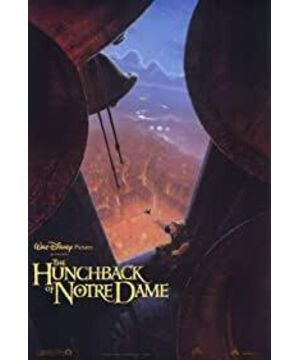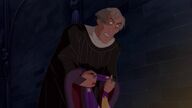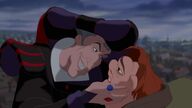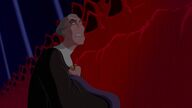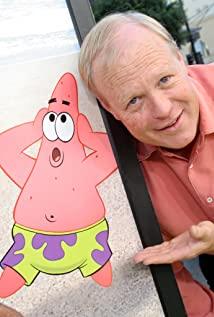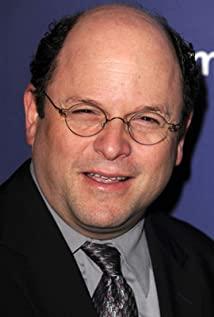First of all, in terms of the storyline, "Notre Dame de Paris" is a very difficult film for cartoons, because the book ends in tragedy, and there is no real villain, even the biggest villain in the book— —In this character image of the vice-bishop Claude Floro, the author uses a multi-faceted character to portray three-dimensionally. Victor Hugo did not attribute the tragedy of the characters in the book to any one person, but They are regarded as victims of religion. The product of the transition from theocratic rule to liberal democracy. Regarding this point, musicals, movies, etc. can be appropriately highlighted with details, but it is difficult for cartoons to do this. Cartoons must adapt to all levels of people, especially the psychological needs of children, which are generally difficult for children to accept A movie that ends in tragedy or is full of villains, so in line with the principle that Disney has always adopted a successful ending, suitable for all ages, it is natural to make a series of huge changes to the ending of the story and the characters.
But with the development of the story, I believe many people will be pleasantly surprised to find that these almost subvert the original changes are so unexpected but reasonable: Floro naturally became the only villain in the film, insidious and cold, wearing a black robe, There is always a slight grin on his face. In an accident, Quasimodo was forcibly adopted, and he was imprisoned in the bell tower not to go out. Quasimodo is portrayed as a brave figure who is like a Spider-Man, with an ugly appearance but a pure and noble heart. Although he obeys Floro's words, he still can't restrain his desire for freedom. The beautiful and kind gypsy girl Esmeda ran into Floro for helping Quasimodo and was hunted down. She hid in the clock tower and met Quasimodo. The arrival of Esmeda made Quasimodo feel warm for the first time. , Helped Esmeida escape the clock tower overnight.
The captain of the guard, Phoebus, is the most changed character in the film. The irritated Floro vowed to burn the entire Paris and capture Esmeralda. The brave and upright Phoebus was unwilling to kill the innocent and violated Floro’s order and was injured. He was rescued by Esmeralda and hid in Notre Dame in Paris. Floro deceived Quasimodo to say that he had found Esmeralda’s. At the gypsy camp, Quasimodo and Phoebus found the news of the "Magic Kingdom" overnight, but they were followed by Floro.
At the end, the scene of the execution ground with Notre Dame as the background is even more commendable. After Floro read the death sentence of Esmeralda (close-up), several soldiers threw wood on the table (close-up) , The angry Esmeda rejected Floro's temptation (close-up), and the angry Floro lit the firewood on the torture stage. The blazing red flame filled the sky (distant view), which also pushed the plot to At the climax, Quasimodo, who was locked in the bell tower, noticed the Esmeda downstairs (transition), angrily broke free from the chains and jumped down from the tall building with a rope (distant view, transition), rescued Esmeda and returned to the bell tower. When he lifted Esmeda high and shouted for refuge (from the perspective of Quasimodo's back, looking down at the crowd below the clock tower), the cheers from the crowd below the clock tower were enough to change his previous experience. All the ridicules, this humble monster seemed so tall at this moment, stepping on all the laws, soldiers, crowds and everything.
In the end, Floro fell off the clock tower during Quasimodo's fight. Quasimodo's adult beauty made Esmerald and Phoebe finally married, and he himself was finally accepted by the citizens. The ending sentence "The bell is That’s so loud because it sounded the death knell of the rich.” This sing goes straight to the theme, sings the aspirations of citizens living at the bottom, echoing in the blue sky like a bell for a long time.
The most common stone statue in Notre Dame de Paris in the film gave life to people and became the biggest highlight in the film. The three stone statues with different personalities make the plot of the story more full and add a lot of jokes to the deserted and sad film. For example, when Quasimodo was encouraged by the stone statue and finally decided to walk out of the bell tower, he was directly blocked by Floro who came to deliver the food; Esmeda said to Quasimodo: "Floro looks at us. Wrong (Chinese dubbing)" was heard by the stone statue as "Floro hooked his pants". These seemingly trivial details not only make the audience smile, but also contribute to the development of the characters and plots below. To pave the way.
What is worth mentioning is the use of colors in the film. In the film, a dark blue cool tone is used as the base color. Quasimodo sings "Heaven's Light" affectionately facing the blue starry sky, and Floro's "Hellfire" roars frantically in the face of the raging flames. 》It has formed a nearly perfect color contrast.
"I know I can't get this kind of light, even if I long for it... Suddenly an angel smiled at me, making the dark bell tower so bright, I believe it is the light of heaven. / Tell me Mar Leah, why should I see her dancing, why his dance would burn my soul...The fire of darkness, the fire of hell, she tormented me, with desire and sin, walking towards The abyss of sin." The
two people standing at the two ends of the scale of good and evil expressed the same desire in different ways. In the shocking singing, I clearly saw the most essential soul of human nature singing in the dark. A lonely dance in the flames.
In short, I can't find any suitable words to describe the success of this film. It is an animation that washes the mind and is the only masterpiece of modern Disney animation that is almost perfect.
View more about The Hunchback of Notre Dame reviews


